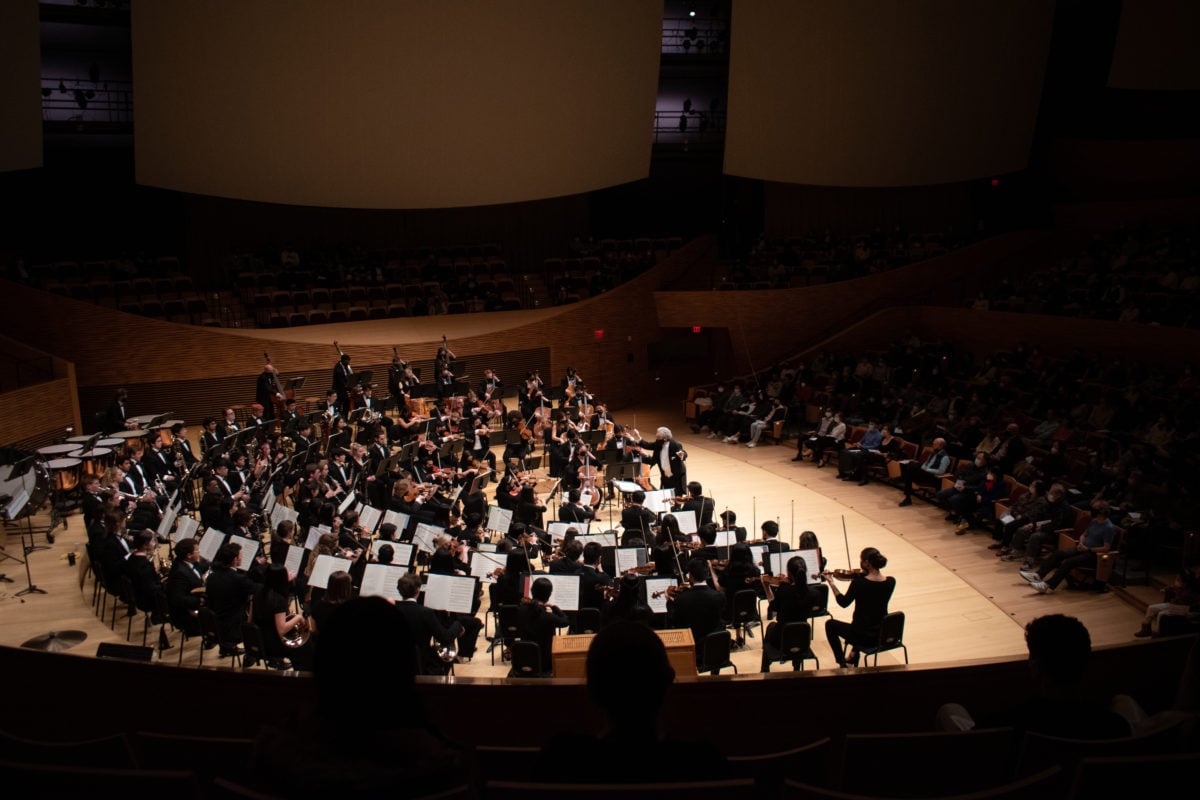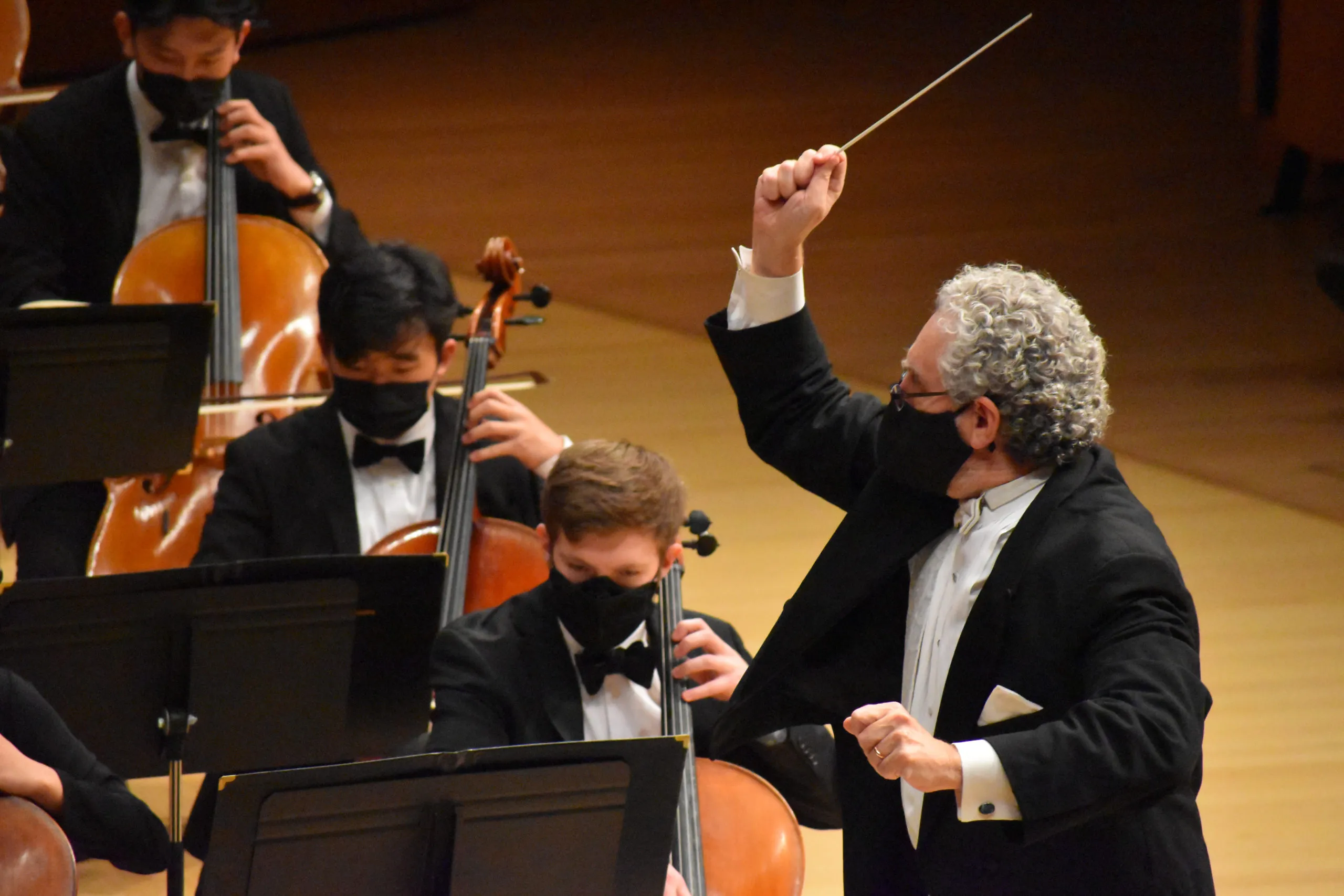Music enthusiasts gathered under the roof of Bing Concert Hall for the Stanford Symphony Orchestra’s (SSO) winter concert on Friday. The show featured the Walton Viola Concerto, performed by Addison Jadwin ’23, and Stravinsky’s ballet “The Rite of Spring.” Like always, this year’s SSO winter concert moved listeners with its masterful, compelling delivery — a feast not only for the ears but also for the eyes.
SSO is one of the leading collegiate orchestras in the United States, and playing in the ensemble has become one of the most sought-after opportunities for music students. SSO concerts have also become an opportunity for faculty members and parents alike to experience world-class live music.
After a brief intermission, we arrived at perhaps the most anticipated part of the program, the six movements of 20th century Russian composer Igor Stravinsky’s orchestral work for the ballet “The Rite of Spring,” whose revolutionary nature caused a riot at its premiere. The piece pioneered the use of polymeter (multiple time signatures in one phrase) and innovative harmonies, portraying a pagan ritual in which the dancers performed mystic nature-worshiping rituals, including the sacrifice of a virgin. SSO’s performance captivated the audience with both its kaleidoscopic sounds and striking physical delivery. With startling phrases coming from different sections of the orchestra played by instruments not commonly incorporated into compositions, such as the English horn or alto flute, I found those around me searching for the origins of certain sounds. As string players took over, we were again impressed by the uniformity of the movement of their bows, which constituted dance movements in and of themselves.
The piece was a dialogue between the wind and string sections; with the former introducing multilayered, light melodies reminiscent of birds chirping in the forest and the latter responding with heavy rhythms that depicted mysterious human activities. I was stunned when the orchestra embarked on the “Augurs of Spring” section, with all the instruments voicing a menacing single-note rhythm that vibrated every corner of the concert hall. It was produced purely from the string instruments unleashing their savage potentials, virtually unassisted by the bass or drums — a testimony to the power of nature that was precisely the theme of “The Rite of Spring.” To say that the sound was majestic would be an understatement. The beat seemed to infiltrate your skin and pulse in your heart even after you left the performance. Although there were no ballet dancers at the concert, you almost wanted to stand up from your seat and stomp to the rhythm yourself to mimic the force and passion with which the string players wielded their bows.
In the age of climate change, the coronavirus pandemic and countless other humanitarian crises, the connection to nature underlying “The Rite of Spring” is as relevant, if not more, to us as it was to its original 20th century audience. SSO’s technically masterful performance of the piece reminded us of both the destructive power of nature and our indestructible link to it. In the midst of a worldwide cultural embargo against Russian art in response to the Russian invasion of Ukraine, I especially appreciated director Paul Philips for delivering this great piece of music to the Stanford community, for the piece should not be defined by its Russian origins alone. Instead, it is a treasure of humanity that needs to be kept alive to inspire generations to come. Walking out of Bing Concert Hall into the chilly night, I was left in deep reflection, completely satisfied except for the urge to see “The Rite of Spring” performed live again as a full ballet production.
SSO also impressed listeners with precision and storytelling in the first half of the program. The opening piece of the three-part program, George Walker’s “Icarus in Orbit,” retold the Greek myth of Icarus ignoring his father’s warning, leading him to melt his wings in the sun and drown. The ensemble impressed me with its wide range of dynamics, as seen in the sharp contrast between the initial peaceful opening of the piece and the dissonant fortissimo at the climax — a section of “controlled chaos,” embodying the tension between the father and son. Hearing the colorful tone created by the melodic percussion that mimicked water drops or the upward spiraling melodies, I could picture a movie-like scene in my head — Icarus soars in the sky arrogantly, until he falls through levels of clouds towards his demise — all to the backdrop of a thundering discord.

The ensemble quickly transitioned from “Icarus in Orbit” to its second piece, the three-movement viola concerto composed by William Walton, featuring the 2020 winner of the annual Concerto Competition, Jadwin, as the soloist. Having slouched down in my seat, I sat up straight in anticipation of the performance. After a calming introduction by the orchestra, Jadwin entered in his middle register with a warm tone, luring the audience in. Unlike the flashy concertos for solo violins, the viola melody was calming and narrative, containing sincere introspections to be unveiled to the audience through low whispers. The solo viola blended in with the orchestra at times, and the audience had to fully concentrate to discern its voice. Jadwin frequently took our breath away with his inquisitive, precise ascending chords, making us wonder where the music would take us.
The second movement, “Vivo con molto preciso,” led the orchestra in something resembling a frenzied dance. I was taken by surprise by Jadwin’s power and passion in his series of “attacking” notes, which disturbed the listener with their aggressive shredding quality and unapologetic shattering of the expectation set up by the previous movement. The concerto ended with the solo viola and the orchestra holding a single chord and fading into nothing. The soloist controlled his bow with the precision of a painter’s brush stroke until the very end, leaving us grasping onto the reverberation of the last sound in the air.
From providing an opportunity for musicians like Jadwin to display their talents to eliciting reflections from listeners, SSO inspired members of the community to celebrate their cultural heritage in light of current realities.
Editor’s Note: This article is a review and contains subjective opinions, thoughts and critiques.
